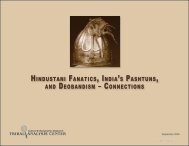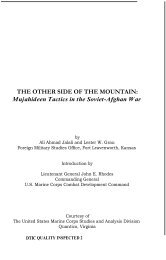ALIKOZAI TRIBAL DYNAMICS: A VERY UNUSUAL DURRANI TRIBE
ALIKOZAI TRIBAL DYNAMICS: A VERY UNUSUAL DURRANI TRIBE
ALIKOZAI TRIBAL DYNAMICS: A VERY UNUSUAL DURRANI TRIBE
You also want an ePaper? Increase the reach of your titles
YUMPU automatically turns print PDFs into web optimized ePapers that Google loves.
Alikozai Tribal Dynamics: A Very Unusual Durrani Tribe<br />
Alikozai Tribal Dynamics: A Very Unusual Durrani Tribe<br />
The Alikozai Durranis are very unlike the other Durrani tribes located in southern Afghanistan. There is a large concentration of this tribe<br />
within the Arghandab Valley and their generally well-defined tribal boundaries may have been responsible for them developing a high degree of<br />
independence. They seem, however, to be estranged from many of their fellow Durranis and have demonstrated their independence by affiliating with<br />
non-Pashtuns during periods of both conflict and political competition. The reasons for their alienation are deeply rooted in the violent history of the<br />
Pashtun tribes. Some of these reasons have been recorded, but much of this history is not available and can only be estimated from the few factors<br />
available. Something – probably a series of “somethings” – set the Alikozai along a generally confrontational path with the other Durranis.<br />
Tribal balance of power was clearly a factor in the intra-tribal strife that was always occurring within these competing tribes. At one time, the<br />
Alikozai tribe was a highly respected part of the Abdali tribes, a large group that would later evolve into the Durrani Confederation. Their early<br />
primacy is illustrated by the fact that an Alikozai, Abd al-Ghani Khan, led the Abdali warriors that were forced to enter Persian Nadir Shah’s service<br />
following their defeat at Herat in 1732. 1 As a reward for their service, according to a Pashtun historian who wrote in 1874, “...the valley of the<br />
Arghandab falling [sic] to Ghani Khan and his clan the Alikozai for distinguished service by the Abdali tribe to Nadir Shah.” 2 This rich valley near<br />
Kandahar remains the primary location of the Alikozai tribe.<br />
Following Nadir Shah’s death in 1747, Ahmad Khan, a Popalzai, was given the leadership of the Abdalis, which he renamed Durranis, and as he<br />
consolidated his power he worked to weaken the other tribes that might later challenge his primacy. For example, the largest of the Abdali/Durrani<br />
tribes, the Barakzai, was weakened when Ahmad Khan, now Ahmad Shah Durrani, ordered the tribe’s Achakzai subtribe to be split from the Barakzai<br />
as a separate tribe within the Abdali/Durrani Confederacy. 3 It is very likely that the Alikozai received similar weakening efforts during the reign of<br />
Ahmad Shah Durrani.<br />
Ahmad Shah’s efforts were in vain, however, and the Barakzai were able to replace the Popalzai monarchs that followed him, but succession crises<br />
that followed allowed unrest to develop among the tribes. In early 1800, the Ghilzai tribes rose in rebellion and soon there were large-scale riots<br />
in Kabul between Sunni and Shia. Equal unrest developed within the Durrani tribes, but most of this is difficult to document – especially the court<br />
intrigue in Kabul in which individual Alikozai tribesmen were involved. One of them was involved in the blinding and subsequent execution of one<br />
of the Barakzai leaders in the region, Fateh Khan. 4<br />
In the two decades of unrest that followed, Afghanistan was divided into three independent chieftainships ruled from Kabul, Herat, and Kandahar.<br />
This was the situation when the British placed Shah Shuja on the throne at Kabul in 1839. By 1842, Shah Shuja had been murdered, and in Herat,<br />
Kamran, the region’s ruler, was murdered by his Wazir, Yar Mohammad Khan, an Alikozai, who assumed control of Herat. 5<br />
1. Noelle, Christine, State and Tribe in Nineteenth Century Afghanistan, pg. 230.<br />
2. Hyat Khan, Muhammad, Afghanistan and its Inhabitants, translated by Henry Priestly, 1981, reprint of 1874 edition, pg.63.<br />
3. Noelle, pg. 230.<br />
4. Ibid, pg. 6.<br />
5. Le Messurier, Augustus, Kandahar in 1879; Lumsden, Harry, The Mission to Kandahar, pgs. 2, 3, 4.<br />
Tribal Analysis Center, 6610-M Mooretown Road, Box 159. Williamsburg, VA, 23188
















